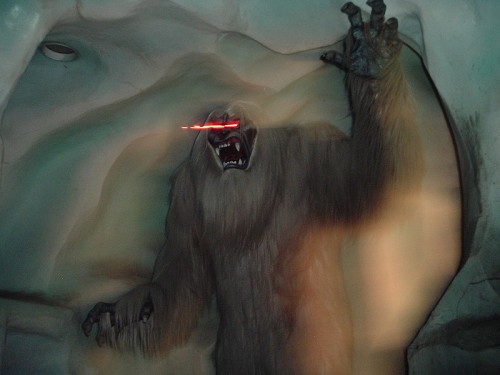The Abominable Snowman
or Yeti
The abominable snowman, or yeti, has many more reliable sightings than bigfoot, but there are more possible explanations.
Some Important Details
Due to the name, many people picture the abominable snowman as white. There have been no sightings of a white creature. All have been black, brown, or red.
A lot of footprints have been seen. Almost all have been in snow, of course, which means that they've been subject to rapid decay from wind and sun.
Sun and Snow
I spent one very cold winter in Galena, Alaska (1983-84).
There the temperature drops into the 20's in September, and the massive Yukon river freezes by November every year.
Nonetheless, Galena gets very little snow. Galena is like a frozen desert. It has very little rainfall and extremely low humidity.
As a result, I learn that snow evaporates, even in sub-zero temperatures. It snowed maybe three times all winter while I was there, and in between, the snow would slowly evaporate ... even in January, when the temperature never climbed above -30 degrees.
Sightings and Accounts
The publicization of the abominable snowman began in 1832 with an account by B.H. Hodgson, British representative to Nepal, that was published in the Journal of the Asiatic Society of Bengal. Occultopedia.com says his servants were attacked by a bipedal creature. On what basis, I don't know. Other reports I've read say they simply saw the beast.
Hodgson himself concluded it was an orangutan.
In 1925, a British photographer named Tombazi reported seeing dark, furry, bipedal creatures as they were descending Zemu glacier. They observed the animals from 200 to 300 yards, then climbed down to where they were when they left. There they discovered footprints, but these were tiny ... only 6 to 7 inches long and 4 inches wide.
In 1938, Captain d'Auvergne, curator of the Victoria Memorial in Calcutta, India said he became snowblind while traveling alone in the Himalayas. He claims that a 9-foot-tall yeti rescued him, took him to a cave, and nursed him back to health. Basically, this story is very hard to believe, even if he was the curator of a memorial. In fact, I laughed out loud the first time I read this report.
 An orangutan is one possible explanation for Yeti sightings | public domain
An orangutan is one possible explanation for Yeti sightings | public domainIn the 1950's, Slavomir Rawicz published a similarly unbelievable account of an escape from a Russian gulag and a walk from Russia to India called The Long Walk. He says he escaped from a Russian gulag and walked from Russia to India. Along the way, he supposedly saw a couple abominable snowmen around 8 feet tall walking in the snow for nearly two hours from perhaps 200 yards away. Personally, like Captain d'Auvergne's claim, I find this story completely invented and the extreme claims of his journey very questionable.
In 1953, Sir Edmund Hillary, the first westerner to scale Mt. Everest, and his Sherpa guide, Tenzing Norgay, reported finding giant footprints. Later, in 1960, Sir Hillary would return with an expedition specifically to find the abominable snowman. After ten months, he would conclude it was just a legend.
Finally, in 1970, a British mountain climber named Don Whillans heard something that his Sherpa guide identified as the call of the abominable snowman. After camping in the mountains that night, he awoke to very human-looking footprints in the snow, then later watched a bipedal creature through binoculars for about 20 minutes.
In addition, there have been many reports of human-looking footprints being found by climbers and travelers, as well as several reports of attacks by abominable snowmen.
Explanations
Skeptics write off the footprints as simply being prints of an animal—usually a bear—that have been enlarged and misshapen by wind and sun.
I don't really buy this explanation. Enlarged, misshapen bear footprints look like the prints of a bare human foot? Repeatedly?
That's not very convincing to me.
Of course, there is always the very strong argument that eye witnesses are not all that reliable. In the snow, in the wilderness, it would not take much for a large bear like the Himalayan Blue Bear to rear up on its hind legs and appear to be ape-like.
That would not be true for 20 minutes or 2 hours, but there's good reason to suspect the longer stories are invented, and the 20-minute view by Don Whillans was through binoculars. Without a good view, it's entirely possible that he was viewing an orangutan.
Desmond Doig, who went on an expedition looking for the abominable snowman with Sir Edmunt Hillary, the first (non-Sherpa) man to climb Mt. Everest, and who's been studying yetis for 30 years thinks that there are 3 explanations:
- Tibetan Blue Bears are known to attack Sherpa cattle. The Sherpa call them Dzu Teh.
- A second animal known to the Sherpa called Thelma that Doig believes is a gibbon.
- True Yeti, a population of large, bipedal, hairy apes living in high elevations. Since they live up near 20,000 feet, they are not often seen by humans.
No less an authority than the editor of Nature magazine said that the stories of the abominable snowman warrant further investigation.
Evolution and the Abominable Snowman
There is nothing about evolution or physiology that would make the yeti impossible. According to testimonies, if they exist, their size could be 7 to 10 feet and large. This is not an impossible size—an ape that size named Gigantopithecus blackii is known to have existed, based on a few jawbones and teeth—and such witnesses as we have, in that wilderness setting, would be prone to exaggerate size anyway.
 Gigantopithecus blackii jaw
Gigantopithecus blackii jawUsed with permission
The editor of Nature was prompted to make his suggestion for further research by the discovery of Homo floresiensis, the "hobbit" of Flores. That tiny bipedal hominid was only discovered in 2004, and they have been extinct for no more than perhaps 13,000 years. Could a similar tiny population of ancient hominids wound up at high elevations in the himalayas?
It seems unlikely that there's really a bipedal, ape-like abominable snowman, but it is not impossible, nor would it be a particularly unusual scientific discovery.
